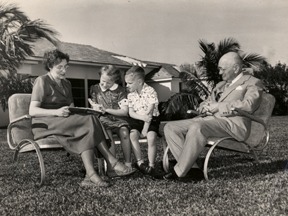An excerpt from Digging for Treasure, Two Pioneer Coal Developers in Portage, Pennsylvania by Jean Crichton
My sharpest memories of Portage, Pennsylvania, date from certain Sundays before my father’s death in 1952 (when I was 8). After church and Sunday dinner at our suburban home in Westmont, outside of Johnstown, Father would suggest “a drive up to the mines.”

In an era before seatbelts, I climbed into the backseat of our maroon Cadillac beside my brother Alan. Piled around us were books and toys, enough, it was hoped, to keep us occupied for the 20-mile trip. Father took the wheel, and our mother, Rose, sat at his side, always half-turned toward us to referee squabbling.
Up steep Frankstown Hill we went, out of Johnstown, past coal towns like Ehrenfeld and South Fork. In summer, we turned off at Lamb’s Bridge, to take the scenic route, on a country road fringed with wildflowers and fields of alfalfa and corn. The road was paved with red bricks, and the car vibrated as it moved along the cobbled surface. Mother always said it was one of the most beautiful drives in the area. If there was air pollution from the mining, I did not see it.
Soon Father drove down the hill into Portage, subdued on a Sunday, and then “up the crick,” a stream really named Trout Run. Our destination was the seemingly vast parking lot of a gritty mine complex—it was Portage Number 4, the Miller Shaft. The tires crunched against black gravel as Father pulled up to a small yellow-brick office building. He turned off the motor and opened the car door.
Outside, the air was quiet. Birds twittered, and crickets chirped. Ours was the only car. It was Sunday, and the mines weren’t working.
Father pulled a jingling key ring from his pocket, unlocked the office door and disappeared. The three of us waited in the car, travelers in a foreign setting, two little children with a tendency to raise a ruckus and our anxious mother, hoping to keep peace.
Out the car window, I stared at the diagonal line of a conveyor belt slanting against the sky. At the top was a towering yet rickety-looking black tipple, the place, Father told me, where coal was “cleaned” (of rock). Clean coal made no sense to my child’s mind. Everyone knew coal was dirty.
After a while, Father came out, locked the door behind him and got back in the car with a quiet remark to Mother.
What did he say? I strained to hear. The coal business was important, I knew, the most important thing in life, it sometimes seemed. But it was a mystery to me, not to be explained.
And then a more pressing question as we drove out of the mine complex—would there be time for ice cream?
If we turned up the road toward the village of Blue Knob, we would come to Long’s Dairy, renowned for its rich, delicious ice cream made right there on the premises. Father’s favorite flavor was coffee. Mine was rainbow. Each time we went to Portage, I prayed there would be time for an ice cream cone.
Jean Crichton has been working on her family stories for many years. Her book, Digging for Treasure, a story of a major business partnership of her father’s, was published in 2009. She is currently working on a book about her extended family which covers the years 1850 to 1948. Subsequently, she will be finishing a partially-written book on her father’s career as a mine owner. She attended the very first, week-long Turning Memories Into Memoirs® writing workshop, which was held in 2000.
 What would happen to the memoir conversation if…
What would happen to the memoir conversation if…
- …you took a moment to present this informative post to your friends and family by linking this article on your social media? Just a click. It’s so easy.
- …you reposted this article on your own blog or website? It’s free and you’d both have some valuable content to boost your blog’s reputation and you would be providing your readers with valuable guidance. For the best procedure on how to do this, click here.
- …you subscribed to our YouTube channel?

No comments yet.